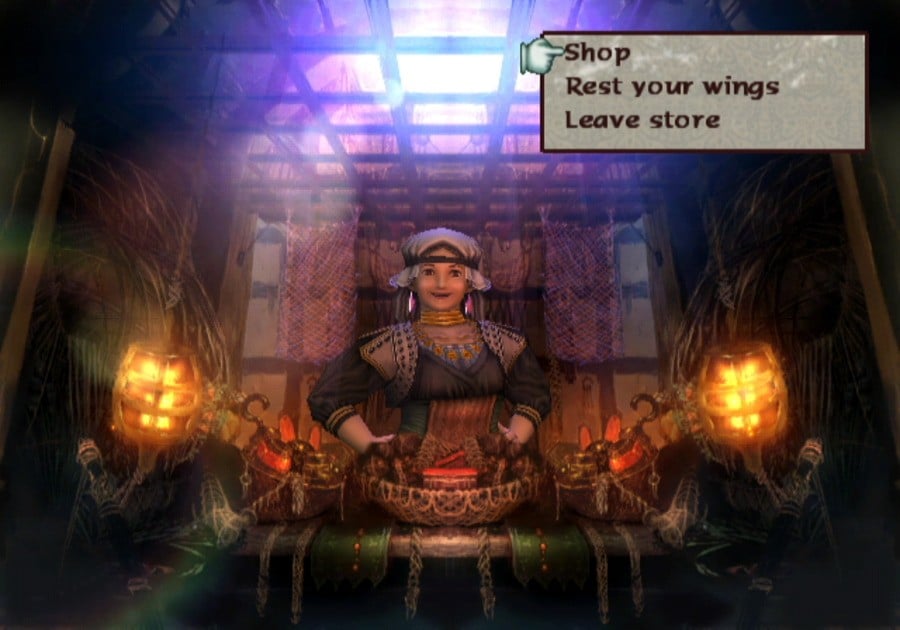Whether The Rumour Is True Or Not, Baten Kaitos Deserves A Remake
Set in a world made up of various floating islands, you follow Kalas, a teenager on a journey to avenge the death of his brother and grandfather. He bumps into Xelha, a young woman who is on a journey to stop the Alfard Empire from unsealing the End Magnus — magical golden cards that seal away pieces of a dead god’s dismembered body. Kalas, haughty and selfish, is reluctant to join her, but it’s an RPG — things never go that simply, do they? So the two journey across the five nations to stop the Magnus from being unsealed. Throw in a giant magical whale, dethroning God, and people with wings, and you’ve got yourself the perfect JRPG recipe.
Baten Kaitos is an early demonstration of Monolith Soft’s talent for creating unique and unusual worlds full of life and colour.
The first thing that makes Baten Kaitos so distinct is that you’re not playing as Kalas, technically. Yes, you’re moving him around the screen, interacting with objects as Kalas, but at the beginning of the game, you’re asked to name and gender a ‘Guardian Spirit’. That Guardian Spirit is you, the player, and Kalas (and other characters) refer to you by name multiple times throughout the game. But why don’t you, the Guardian Spirit know anything about the world? Amnesia! Of course.
I can let the amnesia trope slide, though, because I’ve never seen another game break the fourth wall in this way before, except here and the prequel, Baten Kaitos Origins. You being the Guardian Spirit ensures that you, the player, are an active character in the story. You have to make choices and decisions as Kalas’ Guardian Spirit that increase affinity with your party. Plus, the novelty of characters interacting with you, particularly Xelha who has some very cute conversations with you, doesn’t ever wear off.
The story itself isn’t too special (though notably it’s written by Chrono Cross’ Masato Kato), but Baten Kaitos might have one of the most shocking twists in any RPG I’ve ever played. It’s not something I saw coming, and it completely changes the trajectory of the plot. The drama of it is slightly dampened by the tin-can voice acting, but I’ve grown to love the over-the-top screaming in this cutscene for a quick giggle. Though a remake could make this scene deliciously good with an improved dub.
The ace in Baten Kaitos’ deck, for me, is its world. Baten Kaitos: Eternal Wings and the Lost Ocean is stunning, even today. Both it and its prequel use pre-rendered backgrounds to create some utterly gorgeous scenery and captivating locations. The nation maps look like watercolour tapestries, with clouds and lights drifting across the screen, and ships and transport passing by in the background. Interactive scenery like rubber mud and snow are distinguishable from the beautiful backdrops that catch your eye — I still love seeing the snow part as you walk through a blizzard on your way towards the Ice Kingdom. A remake would probably do away with pre-rendered backdrops, and this is perhaps what I’d be most worried about.
I could easily go on about the gorgeous use of colour and how I adore just how different each island nation is, but it’s not just about how they look, but how creative they are. Sadal Suud, the first island, feels like a typical ‘first’ place for an RPG, but it’s rich in forests, flora, and farming hamlets — and apples. In contrast, Mira is home to a cornucopia of locales — there’s a village made entirely out of confectionary, another that looks like the inside of a children’s storybook, and a dungeon where you walk upside-down and play through a portion of The Tower of Druaga to get around.
Baten Kaitos is an early demonstration of Monolith Soft’s talent for creating unique and unusual worlds full of life and colour. There’s a real sense of place and culture on each of the island nations. There are creatures unique to every island that are inspired by real-life animals — Fluffpups are a bit like Pomeranians and are pets that suggest their owners are posh or have a lot of money, and they’re native to Alfard and the city of Mintaka, while Cloudgulls fly around Pherkard on Sadal Suud. Mira even gets its own unique map music to really hammer home that, yes, this island that looks like a shattered mirror really is this strange.
Perhaps my favourite thing about the world is just how the game’s main mechanic — cards — is implemented into every single facet of Baten Kaitos. From the lore to the items to the gameplay, the cards, called Magnus, make up everything. It may be most well-known for its card-based battle system, which back in the day wasn’t so common (though FromSoftware also has a card-based RPG on the GameCube called Lost Kingdoms from 2002), but what sets Baten Kaitos apart is that Magnus are integral to pretty much everything you do. I’ve already mentioned the End Magnus above, but every single item you use, pick up, or interact with, is a Magnus. To claim any of these items, you have to either buy the card, pick it up in battle or in a chest (for items, weapons, and armour used in combat), or absorb its essence into a blank card.
As you can imagine, pretty much every single puzzle and sidequest revolves around these blank cards by storing items and bringing them to other people or locations to use. There’s one early-game dungeon where you have to absorb the essence of clouds and use them in a generator later on in order to open the path. In another dungeon, you need to transfer the essence of flames to torches to activate the block-pushing puzzles. And sidequests can be as simple as bringing water to an injured person to carrying around the essence of a family tree and getting family members to sign it — both begrudgingly and lovingly. Just think about the absurdity of handing someone a glass of water from a piece of paper. And yet it feels totally normal here.

Normal items change according to your in-game clock — food like meat, apples, and milk all rot or change, and that means their properties change, too. A slab of beef may have an attack power of 40, but in two hours’ time, that will go up to 50, then 60, until it eventually rots — then it has a chance to poison an enemy. What, you thought you’d get to eat the beef? Mattresses break, flame swords burn out, and The Peach Boy eventually turns into the Wonder MOMO. Because there are so many different time-based items, a 100% speedrun of this takes nearly 340 hours.












